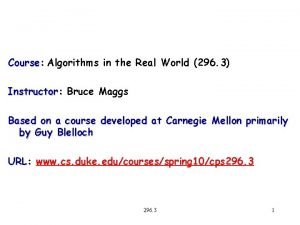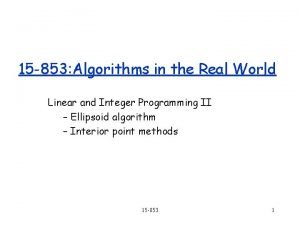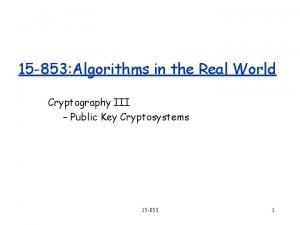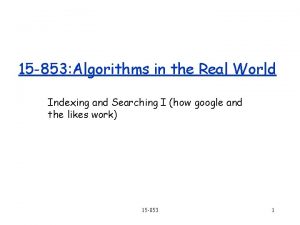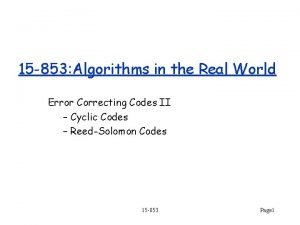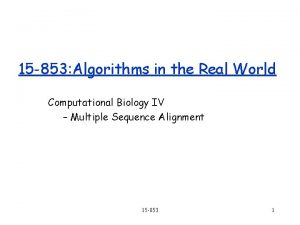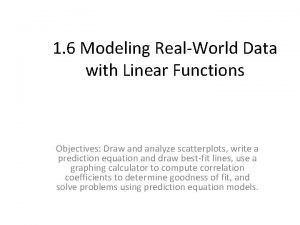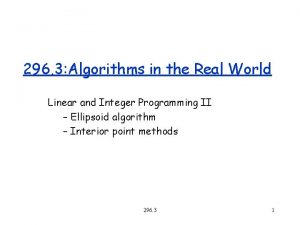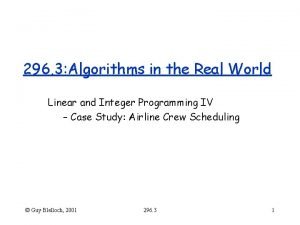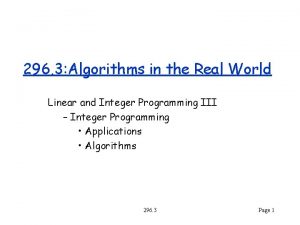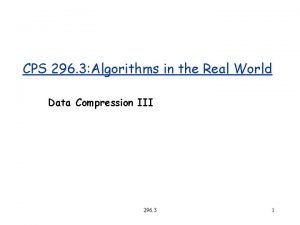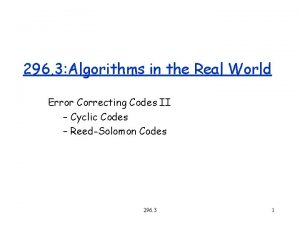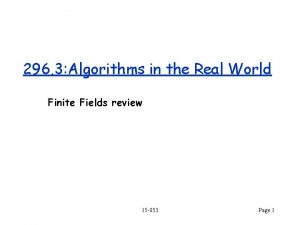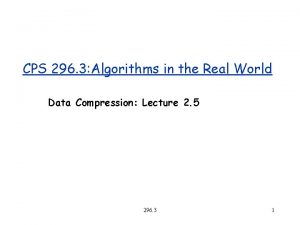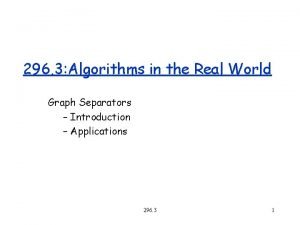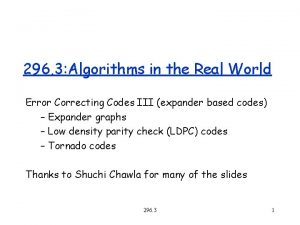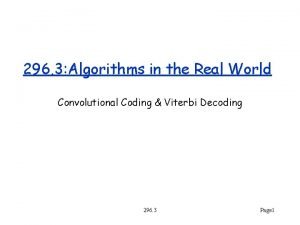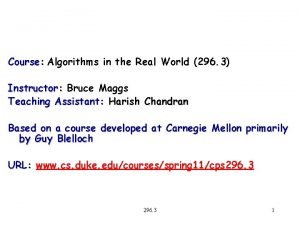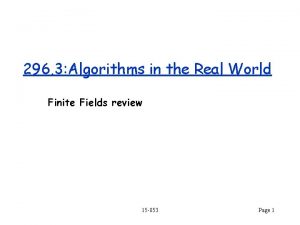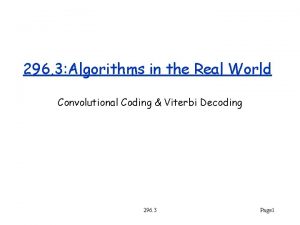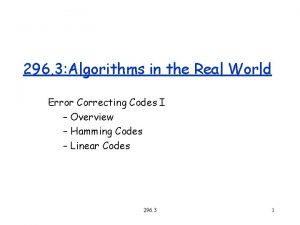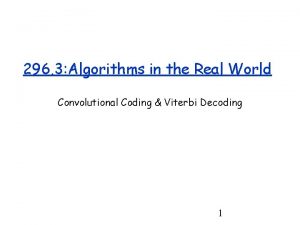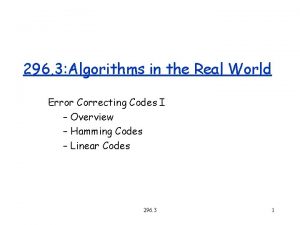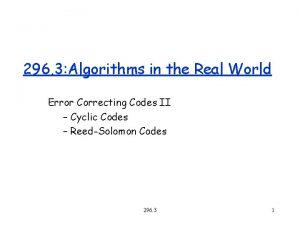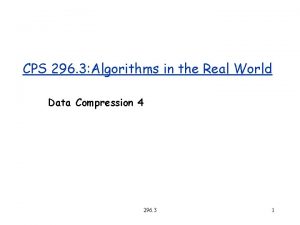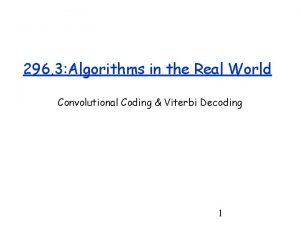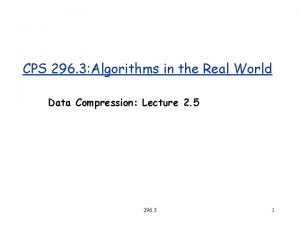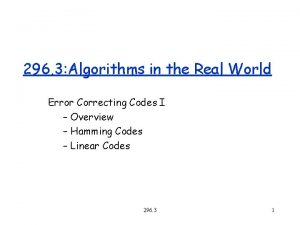296 3 Algorithms in the Real World Linear




















































- Slides: 52

296. 3: Algorithms in the Real World Linear and Integer Programming I – Introduction – Geometric Interpretation – Simplex Method – Dual Formulation 296. 3 Page 1

Linear and Integer Programming Linear or Integer programming (one formulation) find x to minimize z = c. Tx cost or objective function subject to Ax ≤ b inequalities x≥ 0 c R n, b R m , A R n x m Linear programming: x Rn (polynomial time) Integer programming: x Zn (NP-complete) Extremely general framework, especially IP 296. 3 Page 2

Related Optimization Problems Unconstrained optimization min{f(x) : x Rn} Constrained optimization min{f(x) : ci(x) ≤ 0, i I, cj(x) = 0, j E} Quadratic programming min{1/2 x. TQx + c. Tx : ai. Tx ≤ bi, i I, ai. Tx = bj, j E} Zero-One programming min{c. Tx : Ax = b, x {0, 1}n, c Rn, b Rm} Mixed Integer Programming min{c. Tx : Ax ≤ b, x ≥ 0, xi Zn, i I, xr Rn, r R} 296. 3 Page 3

How important is optimization? • • • 50+ packages available 1300+ papers just on interior-point methods 100+ books in the library 10+ courses at most universities 100 s of companies All major airlines, delivery companies, trucking companies, manufacturers, … make serious use of optimization. 296. 3 Page 4

Linear+Integer Programming Outline Linear Programming – General formulation and geometric interpretation – Simplex method – Ellipsoid method – Interior point methods Integer Programming – Various reductions from NP hard problems – Linear programming approximations – Branch-and-bound + cutting-plane techniques – Case study from Delta Airlines 296. 3 Page 5

Applications of Linear Programming 1. A substep in most integer and mixed-integer linear programming (MIP) methods 2. Selecting a mix: oil mixtures, portfolio selection 3. Distribution: how much of a commodity should be distributed to different locations. 4. Allocation: how much of a resource should be allocated to different tasks 5. Network Flows 296. 3 Page 6

Linear Programming for Max-Flow in 1 5 3 2 7 3 6 Create two variables per edge: x 1 Create one equality per vertex: x 1 + x 2 + x 3 ’ = x 1’ + x 2 ’ + x 3 x 1 and two inequalities per edge: x 1 ≤ 3, x 1’ ≤ 3 add edge x 0 from out to in maximize x 0 296. 3 out x 1 ’ x 2 x 3 Page 7

In Practice In the “real world” most problems involve at least some integral constraints. • Many resources are integral • Can be used to model yes/no decisions (0 -1 variables) Therefore “ 1. A subset in integer or MIP programming” is the most common use in practice 296. 3 Page 8

Algorithms for Linear Programming • Simplex (Dantzig 1947) • Ellipsoid (Kachian 1979) first algorithm known to be polynomial time • Interior Point first practical polynomial-time algorithms – Projective method (Karmakar 1984) – Affine Method (Dikin 1967) – Log-Barrier Methods (Frisch 1977, Fiacco 1968, Gill et. al. 1986) Many of the interior point methods can be applied to nonlinear programs. Not known to be poly. time 296. 3 Page 9

State of the art 1 million variables 10 million nonzeros No clear winner between Simplex and Interior Point – Depends on the problem – Interior point methods are subsuming more and more cases – All major packages supply both The truth: the sparse matrix routines, make or break both methods. The best packages are highly sophisticated. 296. 3 Page 10

Comparisons, 1994 problem binpacking Simplex (primal) Simplex (dual) Barrier + crossover 29. 5 62. 8 560. 6 18, 568. 0 won’t run too big 1, 354. 2 1, 911. 4 2, 348. 0 57, 916. 3 89, 890. 9 3, 240. 8 7, 182. 6 16, 172. 2 1, 264. 2 71, 292. 5 108, 015. 0 37, 627. 3 energy 3, 091. 1 1, 943. 8 858. 0 4 color 45, 870. 2 won’t run too big distribution forestry maintenance crew airfleet 296. 3 Page 11

Formulations There are many ways to formulate linear programs: – objective (or cost) function maximize c. Tx, or minimize c. Tx, or find any feasible solution – (in)equalities Ax ≤ b, or Ax ≥ b, or Ax = b, or any combination – nonnegative variables x ≥ 0, or not Fortunately it is pretty easy to convert among forms 296. 3 Page 12

Formulations The two most common formulations: Canonical form minimize c. Tx subject to Ax ≥ b x≥ 0 Standard form slack minimize c. Tx variables subject to Ax = b x≥ 0 e. g. 7 x 1 + 5 x 2 ≥ 7 x 1, x 2 ≥ 0 y 1 7 x 1 + 5 x 2 - y 1 = 7 x 1, x 2 , y 1 ≥ 0 More on slack variables later. 296. 3 Page 13

Geometric View of Canonical Form A polytope in n-dimensional space Each inequality corresponds to a half-space. The “feasible set” is the intersection of the halfspaces This corresponds to a polytope Polytopes are convex: if x, y is in the polytope, so is the line segment joining them. The optimal solution is at a vertex (i. e. , a corner). 296. 3 Page 14

Geometric View of Canonical Form minimize: z = -2 x 1 - 3 x 2 subject to: x 1 – 2 x 2 ≤ 4 2 x 1 + x 2 ≤ 18 x 2 ≤ 10 x 1, x 2 ≥ 0 x 2 ≤ 10 Feasible Set Direction of “Goodness” Corners Objective Function -2 x 1 – 3 x 2 An intersection of 5 halfspaces x 1 – 2 x 2 ≤ 4 296. 3 2 x 1 + x 2 ≤ 18 Page 15

Optimum (max problem) is at a Vertex Holds even if the objective function is merely convex: f is convex if for all vectors x, y S and β [0, 1] f(βx+(1 - β)y) ≤ βf(x) + (1 - β)f(y) f(x) βf(x) + (1 - β)f(y) f(βx+(1 - β)y) 296. 3 Page 16

Optimum (max problem) is at a Vertex Vertices vi Every point q in P is a convex combination of vertices of P. There exist βi q = ∑ β iv i P q If f is linear, then f(q) = f(∑ βivi) = ∑ βif(vi) so mini f(vi) ≤ f(q) ≤ maxi f(vi) 296. 3 Fix convex f, then f(q) = f(∑ βivi) ≤ ∑ βif(vi) ≤ maxi f(vi) Page 17

Geometric View of Canonical Form A polytope in n-dimensional space Each inequality corresponds to a half-space. The “feasible set” is the intersection of the halfspaces. This corresponds to a polytope The optimal solution is at a corner. Simplex moves around on the surface of the polytope Interior-Point methods move within the polytope 296. 3 Page 18

Notes about higher dimensions For n dimensions and no degeneracy (i. e. , A has full row rank) Each corner (extreme point) consists of: – n intersecting (n-1)-dimensional hyperplanes e. g. n = 3, 2 d planes in 3 d – n intersecting edges Each edge corresponds to moving off of one hyperplane (still constrained by n-1 of them) Simplex will move from corner to corner along the edges 296. 3 Page 19

The Simple Essense of Simplex Polytope P Input: min f(x) = cx s. t. x in P = {x: Ax ≤ b, x ≥ 0} Consider Polytope P from canonical form as a graph G = (V, E) with V = polytope vertices, E = polytope edges. 1) Find any vertex v of P. 2) While there exists a neighbor u of v in G with f(u) < f(v), update v to u. 3) Output v. Choice of neighbor if several u have f(u) < f(v)? Termination? Correctness? Running Time? 296. 3 Page 20

Optimality and Reduced Cost The Reduced cost for a hyperplane at a corner is the cost of moving one unit away from the plane along its corresponding edge. z 1 ri = z e i ei pi For minimization, if all reduced costs are nonnegative, then we are at an optimal solution. Finding the most negative reduced cost is one often used heuristic for choosing an edge to leave on 296. 3 Page 21

Reduced cost example x 2 In the example the reduced cost of leaving the plane x 1 is (-2, -3) (2, 1) = -7 since moving one unit off of x 1 will move us (2, 1) units along the edge. We take the dot product of this and the cost function. z = -2 x 1 – 3 x 2 1 ei = (2, 1) ei x 1 – 2 x 2 ≤ 4 296. 3 Page 22

Simplex Algorithm 1. Find a corner of the feasible region 2. Repeat A. For each of the n hyperplanes intersecting at the corner, calculate its reduced cost B. If they are all non-negative, then done C. Else, pick the most negative reduced cost This is called the entering plane D. Move along corresponding edge (i. e. leave that hyperplane) until we reach the next corner (i. e. reach another hyperplane) The new plane is called the departing plane 296. 3 Page 23

Example x 2 Step 2 Departing Step 1 Entering z = -2 x 1 – 3 x 2 Start 296. 3 x 1 Page 24

Simplifying Problem: – The Ax ≤ b constraints not symmetric with the x ≥ 0 constraints. We would like more symmetry. Idea: – Make all inequalities of the form x ≥ 0. Use “slack variables” to do this. Convert into form: minimize c. Tx subject to Ax = b x≥ 0 296. 3 Page 25

Standard Form minimize c. Tx subject to Ax ≤ b x≥ 0 slack minimize c. Tx’ variables subject to A’x’ = b x’ ≥ 0 |A| = m x n i. e. m inequalities, n variables |A’| = m x (m+n) i. e. m equations, m+n variables x 2 ≤ 10 x 1 x 2 x 5 2 x 1 + x 2 ≤ 18 x 1 – 2 x 2 ≤ 4 x 2 296. 3 2 x 1 + x 2 + x 4 = 18 x 4 x 3 Page 26

Example, again x 2 minimize: z = -2 x 1 - 3 x 2 subject to: x 1 – 2 x 2 + x 3 = 4 2 x 1 + x 2 + x 4 = 18 x 2 + x 5 = 10 x 1, x 2 , x 3 , x 4 , x 5 ≥ 0 x 5 x 1 x 4 x 2 x 3 x 1 The equality constraints impose a 2 d plane embedded in 5 d space, looking at the plane gives the figure above 296. 3 Page 27

Using Matrices If before adding the slack variables A has size m x n then after it has size m x (n + m) m can be larger or smaller than n m A= 100… 010… 001… … n m slack vrs. Assuming rows are independent, the solution space of Ax = b is an n-dimensional subspace on n+m variables. 296. 3 Page 28

Gauss-Jordan Elimination Gauss-Jordan elimination i 0 0 1 0 j 296. 3 Page 29

Simplex Algorithm, again 1. Find a corner of the feasible region 2. Repeat A. For each of the n hyperplanes intersecting at the corner, calculate its reduced cost B. If they are all non-negative, then done C. Else, pick the most negative reduced cost This is called the entering plane D. Move along corresponding line (i. e. leave that hyperplane) until we reach the next corner (i. e. reach another hyperplane) The new plane is called the departing plane 296. 3 Page 30

Simplex Algorithm (Tableau Method) n m I 0 Basic Vars. F b’ r -z Free Variables current cost reduced costs This form is called a Basic Solution • the n “free” variables are set to 0 • the m “basic” variables are set to b’ A valid solution to Ax = b if reached using Gaussian Elimination Represents n intersecting hyperplanes If feasible (i. e. , b’ ≥ 0), then the solution is called a Basic Feasible Solution and is a corner of the feasible set 296. 3 Page 31

Corner basic variables free variables x 5 x 1 x 2 x 4 x 3 1 0 0 1 -2 4 0 1 0 2 1 18 0 0 1 10 0 -2 -3 0 x 3 x 4 x 5 x 1 x 2 free variables indicate corner 296. 3 Page 32

Corner x 5 x 1 x 2 1 0 0 -. 5 -1 -2 0 1 0 2. 5 1 20 0 0 1 . 5 1 12 0 0 0 -3. 5 -3 -6 x 2 x 4 x 5 x 1 x 3 x 4 x 3 Exchange free/basic variables by swapping columns, using GE to restore to tableau format. (“corner” not necessarily feasible) 296. 3 Page 33

Corner x 5 x 1 x 2 x 4 x 3 296. 3 1 0 0 1 -2 4 0 1 0 -2 5 10 0 0 1 10 0 2 -7 8 x 1 x 4 x 5 x 3 x 2 Page 34

Corner x 5 x 1 x 2 x 4 x 3 296. 3 1 0 0 . 2 . 4 8 0 1 0 -. 4 . 2 2 0 0 1 . 4 -. 2 8 0 0 0 -. 8 1. 4 x 1 x 2 x 5 x 3 22 x 4 Page 35

Corner x 5 x 1 x 2 x 4 x 3 1 0 0 . 5 -2. 5 -5 0 1 0 . 5 9 0 0 1 10 0 1 -2 18 x 3 x 1 x 5 x 4 x 2 Note that in general there are n+m choose m corners 296. 3 Page 36

Simplex Method Again Once you have found a basic feasible solution (a corner), we can move from corner to corner by swapping columns and eliminating. ALGORITHM 1. Find a basic feasible solution 2. Repeat A. If r (reduced cost ) ≥ 0 , DONE B. Else, pick column i with most negative r (nonbasic gradient heuristic) C. Pick row j with least non-negative bj’/(j’th entry in column i) D. Swap columns E. Use Gaussian elimination to restore form 296. 3 Page 37

Tableau Method A. If r are all non-negative then done n I 0 Basic Variables F b’ r Free Variables values are 0 296. 3 z current cost reduced costs if all ≥ 0 then done Page 38

Tableau Method B. Else, pick the most negative reduced cost This is called the entering plane n I F b’ 0 r z min{ri} entering variable 296. 3 Page 39

Tableau Method C. Move along corresponding line (i. e. , leave that hyperplane) until we reach the next corner (i. e. reach another hyperplane) The new plane is called the departing plane u I F b’ r z 1 0 min positive bj’/uj departing variable 296. 3 Page 40

Tableau Method D. Swap columns x x x b’ x x r No longer in proper form z swap E. Gauss-Jordan elimination I Fi+1 bi+1’ 0 ri+1 zi+1 296. 3 Back to proper form Page 41

Example x 1 x 2 x 3 x 4 x 5 1 -2 1 0 0 4 x 1 – 2 x 2 + x 3 = 4 2 1 0 18 2 x 1 + x 2 + x 4 = 18 0 1 0 0 1 10 x 2 + x 5 = 10 -2 -3 0 0 z = -2 x 1 – 3 x 2 Find corner 1 0 0 1 -2 4 0 1 0 2 1 18 0 0 1 10 0 -2 -3 0 x 3 x 4 x 5 x 1 x 2 x 4 x 3 x 1 = x 2 = 0 (start) 296. 3 Page 42

Example 1 0 0 1 -2 4 0 1 0 2 1 18 0 0 1 10 0 -2 -3 0 x 3 x 4 x 5 x 1 x 2 1 0 0 1 -2 4 -2 0 1 0 2 1 18 18 0 0 1 10 10 0 -2 -3 0 x 3 x 4 x 5 x 1 x 2 18 10 bj/vj 296. 3 x 5 x 1 x 2 x 4 x 3 -2 min positive Page 43

Example swap 1 0 -2 1 0 4 0 1 1 2 0 18 0 0 1 10 0 0 -3 -2 0 0 x 3 x 4 x 2 x 1 x 5 1 0 0 1 2 24 0 1 0 2 -1 8 0 0 1 10 0 -2 3 30 x 3 x 4 x 2 x 1 x 5 296. 3 18 10 x 5 x 1 x 2 x 4 x 3 -2 Gauss-Jordan Elimination Page 44

18 Example 1 0 0 1 2 24 0 1 0 2 -1 8 0 0 1 10 0 -2 3 30 x 3 x 4 x 2 x 1 x 5 10 x 1 x 2 1 0 0 1 2 24 24 0 1 0 2 -1 8 4 0 0 1 10 - 0 0 0 -2 3 30 x 3 x 4 x 2 x 1 x 5 296. 3 x 5 x 4 x 3 -2 Page 45

Example swap 1 1 0 0 2 24 0 2 0 1 -1 8 0 0 1 10 0 -2 0 0 3 30 x 3 x 1 x 2 x 4 x 5 1 0 0 -. 5 20 0 1 0 . 5 -. 5 4 0 0 1 10 0 1 2 38 x 3 x 1 x 2 x 4 x 5 296. 3 18 10 x 5 x 1 x 2 x 4 x 3 -2 Gauss-Jordan Elimination Page 46

Problem? : Unbounded Solution • What if all bj/uj are negative (i. e. , all bj are positive and all uj negative)? • Then there is no bounded solution. • Can move an arbitrary distance from the current corner, reducing cost by an arbitrary amount. • Not really a problem. LP is solved. 296. 3 Page 47

Problem: Cycling • If basic variable swapped in is already zero (b’j=0), don’t reduce total cost. • Can cycle back to already seen vertex! • Solution: Bland’s anticycling rule for tie breaking among columns & rows. 296. 3 Page 48

Simplex Concluding remarks For dense matrices, takes O(n(n+m)) time per iteration Can take an exponential number of iterations. In practice, sparse methods are used for the iterations. 296. 3 Page 49

Duality Primal (P): maximize z = c. Tx subject to Ax ≤ b x ≥ 0 (n equations, m variables) Dual (D): minimize z = y. Tb subject to ATy ≥ c y ≥ 0 (m equations, n variables) Duality Theorem: if x is feasible for P and y is feasible for D, then c. Tx ≤ y. Tb and at optimality c. Tx = y. Tb. 296. 3 Page 50

Duality (cont. ) Optimal solution for both feasible solutions for primal (maximization) feasible solutions for dual (minimization) Quite similar to duality of Maximum Flow and Minimum Cut. Useful in many situations. 296. 3 Page 51

Duality Example Primal: maximize: z = 2 x 1 + 3 x 2 subject to: Dual: minimize: z = 4 y 1 + 18 y 2 + 10 y 3 subject to: x 1 – 2 x 2 ≤ 4 2 x 1 + x 2 ≤ 18 x 2 ≤ 10 x 1, x 2 ≥ 0 y 1 + 2 y 2 ≥ 2 -2 y 1 + Y 2 + Y 3 ≥ 3 y 1, y 2 , y 3 ≥ 0 Solution to both is 38 (x 1=4, x 2=10), (y 1=0, y 2=1, y 3=2). 296. 3 Page 52
 Algorithms in the real world
Algorithms in the real world 15-853 algorithms in the real world
15-853 algorithms in the real world 15-853 algorithms in the real world
15-853 algorithms in the real world 15-853 algorithms in the real world
15-853 algorithms in the real world 15-853 algorithms in the real world
15-853 algorithms in the real world 15-853 algorithms in the real world
15-853 algorithms in the real world Systems of linear equations real world applications
Systems of linear equations real world applications Linear functions in the real world
Linear functions in the real world Real life examples of exponents
Real life examples of exponents Real world vs digital world
Real world vs digital world What is world of forms
What is world of forms Wac 296 305
Wac 296 305 Wac 296-800-160
Wac 296-800-160 Wac 296 305
Wac 296 305 Nnpj-296
Nnpj-296 Sos mihai bravu 296
Sos mihai bravu 296 Wac 296 305
Wac 296 305 E 296
E 296 Wac 296
Wac 296 Wac 296-307
Wac 296-307 Cs 296
Cs 296 Hình ảnh bộ gõ cơ thể búng tay
Hình ảnh bộ gõ cơ thể búng tay Lp html
Lp html Bổ thể
Bổ thể Tỉ lệ cơ thể trẻ em
Tỉ lệ cơ thể trẻ em Chó sói
Chó sói Thang điểm glasgow
Thang điểm glasgow Chúa yêu trần thế
Chúa yêu trần thế Các môn thể thao bắt đầu bằng tiếng nhảy
Các môn thể thao bắt đầu bằng tiếng nhảy Thế nào là hệ số cao nhất
Thế nào là hệ số cao nhất Các châu lục và đại dương trên thế giới
Các châu lục và đại dương trên thế giới Cong thức tính động năng
Cong thức tính động năng Trời xanh đây là của chúng ta thể thơ
Trời xanh đây là của chúng ta thể thơ Cách giải mật thư tọa độ
Cách giải mật thư tọa độ Phép trừ bù
Phép trừ bù Phản ứng thế ankan
Phản ứng thế ankan Các châu lục và đại dương trên thế giới
Các châu lục và đại dương trên thế giới Thể thơ truyền thống
Thể thơ truyền thống Quá trình desamine hóa có thể tạo ra
Quá trình desamine hóa có thể tạo ra Một số thể thơ truyền thống
Một số thể thơ truyền thống Cái miệng xinh xinh thế chỉ nói điều hay thôi
Cái miệng xinh xinh thế chỉ nói điều hay thôi Vẽ hình chiếu vuông góc của vật thể sau
Vẽ hình chiếu vuông góc của vật thể sau Thế nào là sự mỏi cơ
Thế nào là sự mỏi cơ đặc điểm cơ thể của người tối cổ
đặc điểm cơ thể của người tối cổ Ví dụ về giọng cùng tên
Ví dụ về giọng cùng tên Vẽ hình chiếu đứng bằng cạnh của vật thể
Vẽ hình chiếu đứng bằng cạnh của vật thể Vẽ hình chiếu vuông góc của vật thể sau
Vẽ hình chiếu vuông góc của vật thể sau Thẻ vin
Thẻ vin đại từ thay thế
đại từ thay thế điện thế nghỉ
điện thế nghỉ Tư thế ngồi viết
Tư thế ngồi viết Diễn thế sinh thái là
Diễn thế sinh thái là Dạng đột biến một nhiễm là
Dạng đột biến một nhiễm là
